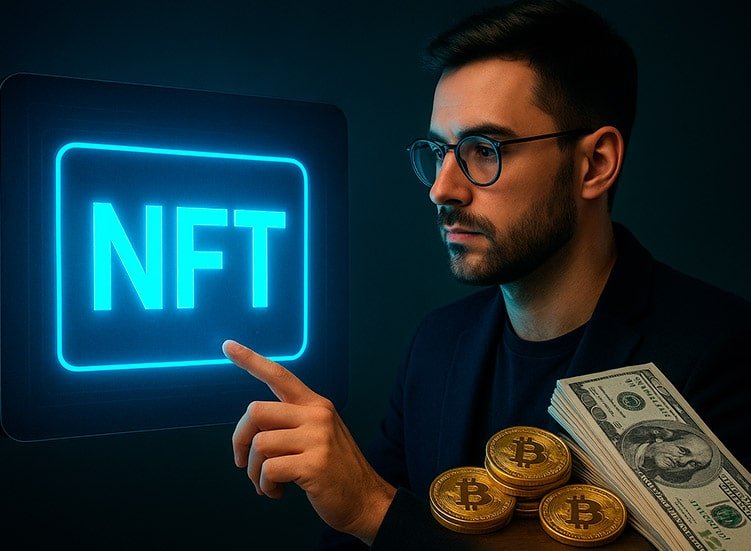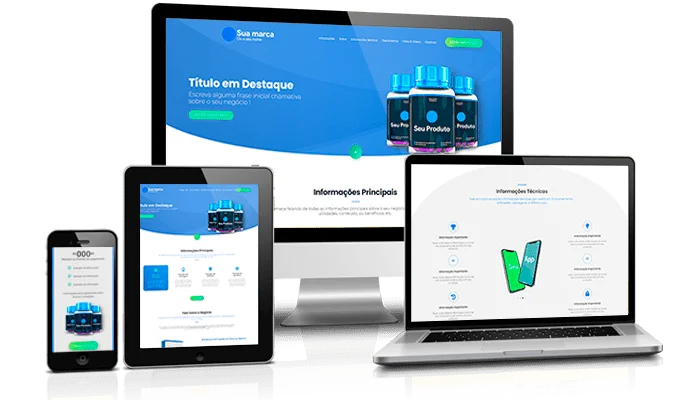You’ve probably heard of NFTs at some point — maybe in a news story about a digital artwork sold for millions of dollars, in online games offering exclusive items, or through artists and brands that launched their own digital collections. But what exactly are NFTs?
NFTs are a revolutionary way of recording digital ownership, using blockchain technology. They allow anyone to create, buy, sell, or collect digital assets in a unique and verifiable way. And more: they are already being used not only in digital art, but also in music, tickets, virtual real estate, games, and much more.
In this guide, you’ll learn:
- What NFTs are and how they work.
- Where and how they started.
- What types of NFTs exist.
- How to create your own NFTs.
- Where to sell and profit from NFTs in a practical way.
- Risks and precautions before investing in this market.
What are NFTs and how do they work in practice?
NFT stands for Non-Fungible Token.
To better understand, let’s break it down:
- Token: a digital record created and stored on a blockchain (a type of public and secure database).
- Non-Fungible: something that is unique and irreplaceable.
- For example:
- Money is fungible. A $100 bill can be exchanged for another $100 bill and it still has the same value.
- An original artwork, however, is non-fungible. A Picasso painting cannot be replaced by just any copy, even if visually identical, because only the original has authentic value.
So, what are NFTs? They are unique digital records that prove the authenticity and ownership of an asset, whether it’s a digital artwork, a song, a video, a game item, a domain name, or even virtual real estate.
How did NFTs begin?
The first experiments with NFTs appeared around 2012 with a project called Colored Coins, which used the Bitcoin blockchain to mark digital assets. But the movement really gained traction in 2017 with the creation of the game CryptoKitties, where players bought and collected unique virtual cats on the Ethereum blockchain.
Since then, NFTs have evolved far beyond digital collectibles. They are now used in:
- Digital art (works by artists sold on marketplaces such as OpenSea and Rarible).
- Play-to-earn games, such as Axie Infinity.
- Music, allowing independent artists to sell exclusive tracks.
- Digital tickets, helping to prevent fraud in events.
- Metaverse, with the purchase and sale of virtual land.
In other words, what started as a curiosity has become a multibillion-dollar industry, with opportunities for both investors and creators.
Which assets can be turned into NFTs?
The beauty of NFTs is that practically anything digital can be tokenized. Some of the most common examples include:
- 🎨 Digital art (paintings, illustrations, animations).
- 🎵 Music and albums by independent artists.
- 🎥 Exclusive videos and clips.
- 🕹️ Game items (weapons, characters, skins).
- 🌐 Blockchain-based domain names.
- 🏠 Virtual land and real estate in the metaverse.
- 📄 Authenticated digital documents.
- 👟 Physical products with NFT certificates, such as sneakers, clothing, or even cars.
In other words, if something can be digitized and has exclusivity value, it can become an NFT.
How to create your own NFT digital tokens?
Now that you understand what NFTs are, let’s get to the important part: how to create your own digital tokens. This process is known as minting and involves turning a digital file into a unique asset registered on the blockchain. I’ll detail each step so you don’t get lost.
1. Choose the content to be turned into an NFT
The first step is to define what you want to tokenize. NFTs can represent any type of digital file, such as:
- Digital art: paintings, illustrations, animated GIFs, 3D images.
- Photography: professional photos, artistic selfies, or themed collections.
- Music and audio: singles, albums, sound effects, or exclusive soundtracks.
- Videos: short clips, animations, or exclusive content for collectors.
- Digital collectibles: game characters, skins, digital cards.
💡 Pro tip: Before creating the NFT, organize important metadata such as title, detailed description, edition number, and unique traits. This helps increase the perceived value of your NFT in the marketplace.
Tools that help create NFTs:
1. OpenSea
- What it does: In addition to being a marketplace, it allows you to create NFTs directly on the platform (lazy minting without paying an upfront fee until the sale).
- Blockchain: Ethereum and Polygon.
Visit Website
2. Rarible
-
What it does: Easy NFT creation, royalty setup, collection support, and integration with multiple blockchains.
-
Blockchain: Ethereum, Flow, and Tezos.
Visit Website
3. Mintable
-
What it does: Intuitive platform for creating NFTs without technical knowledge; supports instant sales and auctions.
-
Blockchain: Ethereum.
Visit Website
4. Magic Eden
-
What it does: Focused on Solana, it allows quick NFT creation and collection management with low fees.
Visit Website
5. Binance NFT
-
What it does: NFT creation, buying, and selling integrated with the Binance exchange; ideal for users who already have a Binance account.
Visit Website
6. NFT Creator Tools
There are also specific tools to make artwork and NFT attributes easier to design:
-
Canva: lets you create ready-to-use digital artwork for NFTs.
-
Figma / Photoshop / Illustrator: for professional designs and layered collections.
-
PixelChain and Appy Pie NFT Maker: generate compatible files for minting in marketplaces.
Just search on Google for NFT Creator Tools, and you’ll find plenty of options.
2. Create a digital wallet
To store NFTs and receive payments, you’ll need a digital wallet compatible with NFTs. Some of the most popular are:
-
MetaMask – compatible with Ethereum and related networks.
-
Trust Wallet – supports multiple blockchains.
-
Coinbase Wallet – great for beginners already using the Coinbase exchange.
🔒 Security: Never share your private keys. They are the only way to access your NFTs and cryptocurrencies.
3. Add cryptocurrency to your wallet
NFTs are usually created on the Ethereum blockchain, so you’ll need ETH to pay for minting fees (known as gas fees).
-
Fee values vary depending on the network and blockchain congestion.
-
On other blockchains, such as Polygon or Solana, you’ll need the corresponding cryptocurrency (MATIC or SOL), usually with lower fees.
💡 Pro tip: Start with small amounts to test the process before investing larger sums.
4. Choose an NFT marketplace
The marketplace is where you’ll create, showcase, and sell your NFT. Some of the most popular options include:
-
OpenSea – the largest Ethereum marketplace; ideal for artists and collectibles.
-
Rarible – allows easy minting and royalty setup.
-
Magic Eden – focused on Solana, fast and low-cost.
-
Binance NFT – integrated with the Binance exchange, good for beginners.
💡 Pro tip: Check creation fees, platform reputation, and target audience before making your choice.
5. Upload and configure your NFT
Now it’s time to turn your digital file into a token:
-
Upload the digital file: select the file you want to tokenize.
-
Title and description: use words that clearly describe the piece and its uniqueness.
-
Quantity: define whether the NFT will be unique or if it will have multiple limited copies.
-
Price: choose between fixed price or auction.
-
Royalties: set the percentage you’ll receive from future resales (optional but highly recommended).
💡 Pro tip: An NFT with clear metadata, detailed description, and visible attributes significantly increases your chances of selling.
6. Complete the minting
After setting up your NFT and paying the creation fee (gas fee), the token will be registered on the blockchain. This ensures:
-
Official ownership of the NFT.
-
Authenticity and traceability of the digital item.
-
The possibility of immediate or future resale in marketplaces.
Congratulations! Your NFT is now officially created and ready to be sold or collected.
7. Next steps after creating your NFT
Creating the NFT is just the beginning. To sell and monetize, you need to:
-
Promote your NFT on social media, Discord communities, art forums, and collector groups.
-
Define a pricing strategy: consider rarity, audience demand, and market trends.
-
Track royalties: many marketplaces automatically pay a percentage from future resales, ensuring passive income.
💡 Advanced tip: Creating collections or themed series increases engagement and perceived value, especially in digital art and gaming markets.
Where to sell your digital NFT tokens?
After creating, it’s time to sell. The main marketplaces offer different options:
- Direct sale with fixed price: you set the value, and buyers can purchase instantly.
- Auction: the NFT is sold to the highest bidder.
- Bundle sales: ideal for collections with multiple items.
Additionally, you can set up automatic royalties. This means that even if your NFT is resold in the future, you’ll receive a percentage of every transaction.
Example: if you set 10% royalties, every time someone resells your work, you continue to earn income.
What are the risks and precautions when investing in NFTs?
Despite being promising, the NFT market also involves risks you need to consider:
- Volatility: prices can fluctuate a lot in a short period of time.
- Fraud and plagiarism: some people attempt to sell artworks that don’t belong to them.
- High fees: during peak demand, gas fees can become expensive.
- Liquidity: it’s not always easy to find buyers for your NFT.
✅ Tips to avoid problems:
- Always verify the authenticity of the creator.
- Prefer well-established marketplaces.
- Never invest more than you can afford to lose.
- Diversify your digital assets.
❓ FAQ – Frequently Asked Questions about What are NFTs
NFTs are unique digital records that prove ownership of an asset, such as art, music, or a game item.
Yes. Today, marketplaces like OpenSea and Rarible allow you to create NFTs in a simple and intuitive way.
Almost anything digital: images, videos, music, art, game items, virtual land, documents, and more.
By creating and selling NFTs, earning royalties from resales, or investing in collections that increase in value over time.
Most of the time, yes, because there are blockchain fees (gas fees). But some marketplaces offer free creation options (lazy minting).
Conclusion: What Are NFTs and How to Get Started Today
Now you already know what NFTs are, how they work, how they started, and how to create your own. They represent a breakthrough in the way we deal with digital ownership and can be an excellent opportunity for artists, content creators, gamers, and investors.
But remember: like any growing market, it requires study, caution, and strategy.
Did you enjoy this content? Share it with someone who also wants to learn how to create and sell NFTs!
Click here for more content about Technology & News.
Click here for more content about Finances & Investments.








